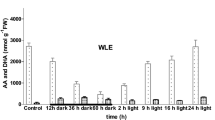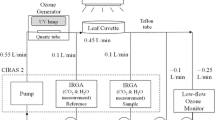Abstract
Tropospheric ozone (O3) decreases photosynthesis, growth, and yield of crop plants, while elevated carbon dioxide (CO2) has the opposite effect. The net photosynthetic rate (P N), dark respiration rate (R D), and ascorbic acid content of rice leaves were examined under combinations of O3 (0, 0.1, or 0.3 cm3 m−3, expressed as O0, O0.1, O0.3, respectively) and CO2 (400 or 800 cm3 m−3, expressed as C400 or C800, respectively). The P N declined immediately after O3 fumigation, and was larger under O0.3 than under O0.1. When C800 was combined with the O3, P N was unaffected by O0.1 and there was an approximately 20 % decrease when the rice leaves were exposed to O0.3 for 3 h. The depression of stomatal conductance (g s) observed under O0.1 was accelerated by C800, and that under O0.3 did not change because the decline under O0.3 was too large. Excluding the stomatal effect, the mesophyll P N was suppressed only by O0.3, but was substantially ameliorated when C800 was combined. Ozone fumigation boosted the R D value, whereas C800 suppressed it. An appreciable reduction of ascorbic acid occurred when the leaves were fumigated with O0.3, but the reduction was partially ameliorated by C800. The degree of visible leaf symptoms coincided with the effect of the interaction between O3 and CO2 on P N. The amelioration of O3 injury by elevated CO2 was largely attributed to the restriction of O3 intake by the leaves with stomatal closure, and partly to the maintenance of the scavenge system for reactive oxygen species that entered the leaf mesophyll, as well as the promotion of the P N.
Similar content being viewed by others
Abbreviations
- AA:
-
L-ascorbic acid
- C i :
-
intercellular CO2 concentration
- DHA:
-
dehydro-L-ascorbic acid
- g s :
-
stomatal conductance
- P N :
-
net photosynthetic rate
- PPFD:
-
photosynthetic photon flux density
- R D :
-
dark respiration rate
- RDS:
-
redox state of ascorbic acid
References
Baier, M., Kandlbinder, A., Golldack, D., Dietz, K.-J.: Oxidative stress and ozone: perception, signaling and response.-Plant Cell Environ. 28: 1012–1020, 2005.
Barnes, J., Zheng, Y., Lyons, T.: Plant resistance to ozone: the role of ascorbate.-In: Omasa, K., Saji, H., Youssefian, S., Kondo, N. (ed.): Air Pollution and Plant Biotechnology. Prospects for Phytomonitoring and Phytoremediation. Pp. 235–252. Springer-Verlag, Tokyo 2002.
Bernacchi, C.J., Leakey, A.D.B., Heady, L.E., Morgan, P.B., Dohleman, F.G., McGrath, J.M., Gillespie, K.M., Wittig, V.E., Rogers, A., Long, S.P., Ort, D.R.: Hourly and seasonal variation in photosynthesis and stomatal conductance of soybean grown at future CO2 and ozone concentrations for 3 years under fully open-air field conditions.-Plant Cell Environ. 29: 2077–2090, 2006.
Booker, F.L., Burkey, K.O., Pursley, W.A., Heagle, A.S.: Elevated carbon dioxide and ozone effects on peanut: I. Gas-exchange, biomass, and leaf chemistry.-Crop Sci. 47: 1475–1487, 2007.
Burkey, K.O., Neufeld, H.S., Souza, L., Chappelka, A.H., Davidson, A.W.: Seasonal profiles of leaf ascorbic acid content and redox state in ozone-sensitive wildflowers.-Environ. Pollut. 143: 427–434, 2006.
Bussotti, F., Gravano, E., Grossoni, P., Tani, C., Mori, B.: Ultrastructural response of a Mediterranean shrub species to O3.-In: Karnoski, D.F., Percy, K.E., Chappelka, A.H., Simpson, C., Pikkarainen, J. (ed.): Air Pollution, Global Change and Forests in the New Millennium. Pp. 259–268. Elsevier, Oxford 2003.
Cardoso-Vilhena, J., Balaguer, L., Eamus, D., Ollerenshaw, J., Barnes, J.: Mechanisms underlying the amelioration of O3-induced damage by elevated atmospheric concentrations of CO2.-J. exp. Bot. 55: 771–781, 2004.
Chen, Z., Gallie, D.R.: Increasing tolerance to ozone by elevating foliar ascorbic acid confers greater protection against ozone than increasing avoidance.-Plant Physiol. 138: 1673–1689, 2005.
Davey, M.W., Van Montagu, M., Inzé, D.: Ascorbate metabolism and stress.-In: Inzé, D., Van Montagu, M. (ed.): Oxidative Stress in Plants. Pp. 271–296. Taylor & Francis, London-New York 2002.
Donnelly, A., Jones, M.B., Burke, J.I., Schnieders, B.: Elevated CO2 provides protection from O3 induced photosynthetic damage and chlorophyll loss in flag leaves of spring wheat (Triticum aestivum L. cv. ‘Minaret’).-Agr. Ecosyst. Environ. 80: 159–168, 2000.
Feng, Z.-Z., Yao, F.-F., Chen, Z., Wang, X.-K., Zheng, Q.-W., Feng, Z.-W.: Response of gas exchange and yield components of field-grown Triticum aestivum L. to elevated ozone in China.-Photosynthetica 45: 441–446, 2007.
Foyer, C.H.: Ascorbic acid.-In: Alscher, R.G., Hess, J.L. (ed.): Antioxidant in Higher Plants. Pp. 31–58. CRC Press, Boca Raton 1993.
Hill, A.C., Littlefield, N.: Ozone. Effect on apparent photosynthesis, rate of transpiration, and stomatal closure in plants.-Environ. Sci. Technol. 3: 52–56, 1969.
Horie, T., Baker, J.T., Nakagawa, H., Matsui, T., Kim, H.Y.: Crop ecosystem responses to climatic change: rice.-In: Reddy, K.R., Hodges, H.F. (ed.): Climate Change and Global Crop Productivity. Pp. 81–106. CABI Publishing, Oxford 2000.
Imai, K.: [Acquisition and cultivation of plant materials.]-In: Kato, S., Miyachi, S., Murata, Y. (ed.): Methods in Photosynthesis Research. Pp. 467–473. Kyoritsu-shuppan, Tokyo 1981. [In Jap.]
Imai, K.: [Global environmental change and field crops.]-Environ. Control Biol. 31: 129–137, 1993. [In Jap.]
Izuta, T.: Air pollution impacts on vegetation in Japan.-In: Emberson, L., Ashmore, M., Murray, F. (ed.): Air Pollution Impacts on Crops and Forests. A Global Assessment. Pp. 89–101. Imperial College Press, London 2003.
Jaspers, P., Kollist, H., Langebartels, C., Kangasjärvi, J.: Plant responses to ozone.-In: Smirnoff, N. (ed.): Antioxidants and Reactive Oxygen Species in Plants. Pp. 268–292. Blackwell Publishing, Oxford 2005.
Jeong, Y.-H., Nakamura, H., Ota, Y.: [Physiological studies on photochemical oxidants injury in rice plants. I. Varietal differences of abscisic acid content and its relation to the resistance to ozone.]-Jap. J. Crop Sci. 49: 456–460, 1980. [In Jap.]
Kangasjärvi, J., Jaspers, P., Kollist, H.: Signalling and cell death in ozone-exposed plants.-Plant Cell Environ. 28: 1021–1036, 2005.
Kerstiens, G.: Diffusion of water vapour and gasses across cuticles and through stomatal pores presumed closed.-In: Kerstiens, G. (ed.): Plant Cuticles. An Integrated Functional Approach. Pp. 121–134. BIOS Scientific Publishers, Oxford 1996.
Kimball, B.A.: Carbon dioxide and agricultural yield: An assemblage and analysis of 430 prior observations.-Agron. J. 75: 779–788, 1983.
Kubo, S., Doke, M., Fujita, S., Motozawa, M., Mizutani, R., Mizuno, S.: [A Manual of Experiments for Food Science.]-Pp. 1–113. Ishiyaku-shuppan, Tokyo 1994. [In Jap.]
Lawson, T., Craigon, J., Tulloch, A.-M., Black, C.R., Colls, J.J., Landon, G.: Photosynthetic responses to elevated CO2 and O3 in field-grown potato (Solanum tuberosum).-J. Plant Physiol. 158: 309–323, 2001.
Lee, E.H.: Early detection, mechanisms of tolerance, and amelioration of ozone stress in crop plants.-In: Agrawal, S.B., Agrawal, M. (ed.): Environmental Pollution and Plant Responses. Pp. 203–222. CRC Press, Boca Raton 2000.
Maddison, J., Lyons, T., Plöchl, M., Barnes, J.: Hydroponically cultivated radish fed L-galactono-1,4-lactone exhibit increased tolerance to ozone.-Planta 214: 383–391, 2002.
Morison, J.I.L., Gifford, R.M.: Stomatal sensitivity to carbon dioxide and humidity. A comparison of two C3 and two C4 grass species.-Plant Physiol. 71: 789–796, 1983.
Morita, S., Tanaka, K.: Detoxification of active oxygen species and tolerance in plants exposed to air pollutants and CO2.-In: Omasa, K., Saji, H., Youssefian, S., Kondo, N. (ed.): Air Pollution and Plant Biotechnology. Prospects for Phytomonitoring and Phytoremediation. Pp. 253–267. Springer-Verlag, Tokyo 2002.
Mulholland, B.J., Craigon, J., Black, C.R., Colls, J.J., Atherton, J., Landon, G.: Impact of elevated atmospheric CO2 and O3 on gas exchange and chlorophyll content in spring wheat (Triticum aestivum L).-J. exp. Bot. 48: 1853–1863, 1997.
Nakamura, H., Hashimoto, S., Ota, Y., Nakano, M.: [Photochemical oxidants injury in rice plants. I. Occurrence of photochemical oxidants injury in rice plants at Kanto area and its symptoms.]-Proc. Crop Sci. Soc. Jap. 44: 312–319, 1975. [In Jap.]
Nouchi, I.: Changes in antioxidant levels and activities of related enzymes in rice leaves exposed to ozone.-Soil Sci. Plant Nutr. 39: 309–320, 1993.
Nouchi, I.: [Plant Responses to Atmospheric Environmental Change.]-Yokendo, Tokyo 2001. [In Jap.]
Nouchi, I.: Agricultural countermeasures for avoiding crop injury from ozone in Japan.-J. agr. Meteorol. 59: 59–67, 2003.
Oksanen, E., Sober, J., Karnosky, D.F.: Impacts of elevated CO2 and/or O3 on leaf ultrastructure of aspen (Populus tremuloides) and birch (Betula papyrifera) in the Aspen FACE experiment.-Environ. Pollut. 115: 437–446, 2001.
Olszyk, D.M., Wise, C.: Interactive effects of elevated CO2 and O3 on rice and flacca tomato.-Agr. Ecosyst. Environ. 66: 1–10, 1997.
Ookoshi, T., Imai, K.: [Effects of elevated concentrations of atmospheric ozone and carbon dioxide on the growth and yield of lowland rice.]-Proc. Kanto Branch, Crop Sci. Soc. Jap. 13: 60–61, 1998. [In Jap.]
Rao, M.V., Hale, B.A., Ormrod, D.P.: Amelioration of ozone-induced oxidative damage in wheat plants grown under high carbon dioxide. Role of antioxidant enzymes.-Plant Physiol. 109: 421–432, 1995.
Roe, J.H., Oesterling, M.J.: The determination of dehydroascorbic acid and ascorbic acid in plant tissues by the 2,4-dinitrophenylhydrazine method.-J. biol. Chem. 152: 511–517, 1944.
Roshchina, V.V., Roshchina, V.D.: Ozone and Plant Cell.-Pp. 27–54. Kluwer Academic Publishers, Dordrecht 2003.
Rudorff, B.F.T., Mulchi, C.L., Lee, E., Rowland, R., Pausch, R.: Photosynthetic characteristics in wheat exposed to elevated O3 and CO2.-Crop Sci. 36: 1247–1251, 1996.
Smirnoff, N.: Ascorbate, tocopherol and carotenoids.-In: Smirnoff, N. (ed.): Antioxidants and Reactive Oxygen Species in Plants. Pp. 53–86. Blackwell Publishing, Oxford 2005.
Torsethaugen, G., Pell, E.J., Assmann, S.M.: Ozone inhibits guard cell K+ channels implicated in stomatal opening.-Proc. nat. Acad. Sci. USA 96: 13577–13582, 1999.
Toyama, S., Yoshida, M., Niki, T., Ohashi, T., Koyama, I.: Studies on ultrastructure and function of photosynthetic apparatus in rice cells IV. Effect of low dose and intermittent fumigation of ozone on the ultrastructure of chloroplasts in rice leaf cells.-Jap. J. Crop Sci. 58: 664–672, 1989.
Unthworth, H.M., Hogsett, W.E.: Combined effects of CO2, temperature, UV-B radiation and O3 on crop growth.-In: Bazzaz, F., Sombroek, W. (ed.): Global Climate Change and Agricultural Production. Pp. 171–197. FAO-John Wiley & Sons, Chichester 1996.
Vandermeiren, K., Black, C., Lawson, T., Casanova, M.A., Ojanperä, K.: Photosynthetic and stomatal responses of potatoes grown under elevated CO2 and/or O3 — results from the European CHIP-programme.-Eur. J. Agron. 17: 337–352, 2002.
Weigel, H.-J.: Air pollutants: Interactions with elevated carbon dioxide.-In: Goodman, R.M. (ed.): Encyclopedia of Plant and Crop Science. Pp. 13–19. Marcel Dekker, New York 2004.
Wittig, V.E., Ainsworth, E.A., Long, S.P.: To what extent do current and projected increases in surface ozone affect photosynthesis and stomatal conductance of trees? A meta-analytic review of the last 3 decades of experiments.-Plant Cell Environ. 30: 1150–1162, 2007.
Xu, H., Biswas, D.K., Li, W.-D., Chen, S.-B., Zhang, L., Jiang, G.-M., Li, Y.-G.: Photosynthesis and yield responses of ozone-polluted winter wheat to drought.-Photosynthetica 45: 582–588, 2007.
Zheng, Y., Lyons, T., Ollerenshaw, J.H., Baynes, J.D.: Ascorbate in the leaf apoplast is a factor mediating ozone resistance in Plantago major.-Plant Physiol. Biochem. 38: 403–411, 2000.
Author information
Authors and Affiliations
Corresponding author
Rights and permissions
About this article
Cite this article
Imai, K., Kobori, K. Effects of the interaction between ozone and carbon dioxide on gas exchange, ascorbic acid content, and visible leaf symptoms in rice leaves. Photosynthetica 46, 387–394 (2008). https://doi.org/10.1007/s11099-008-0070-4
Received:
Accepted:
Published:
Issue Date:
DOI: https://doi.org/10.1007/s11099-008-0070-4




